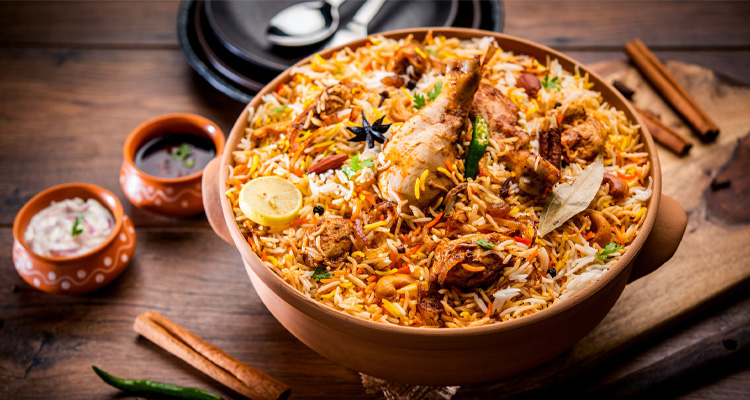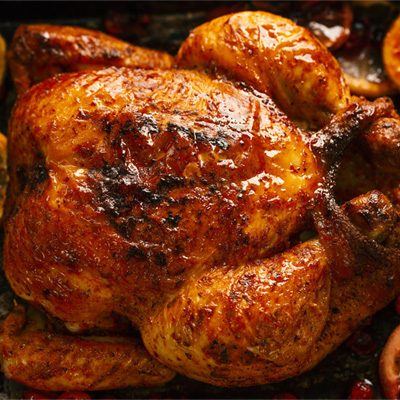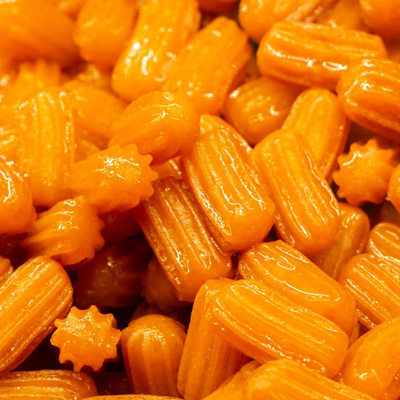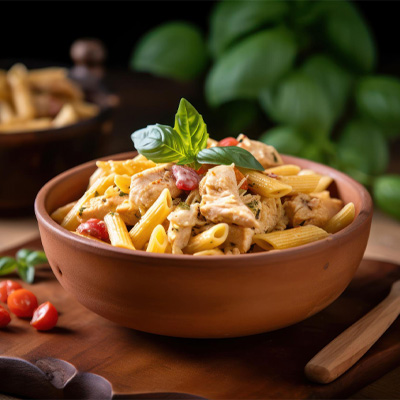Indian Biryani rice, with its tantalizing blend of spices and fragrant rice, is a cherished dish that epitomizes the rich culinary heritage of India. This article embarks on a culinary adventure, unraveling the secrets of creating the perfect Biryani rice. From its historical roots to the diverse regional adaptations, join us on this flavorful journey.
Nutrition Facts
- Kcal
420 - Fat
14 g - Choles
55 mg - Sodium
800 mg - Carbs
55 g - Fiber
3 g - Sugar
4 g - Protein
18 g
Note: The nutrition facts are approximate values and may vary based on the specific ingredients used and any additional toppings or syrups added.
Ingredients
- 2 cups basmati rice, soaked and drained
- 1 lb (450g) chicken, cut into pieces (or vegetables for a vegetarian version)
- 2 large onions, thinly sliced
- 2 tomatoes, chopped
- 1/2 cup plain yogurt
- 1/4 cup fresh cilantro, chopped
- 1/4 cup fresh mint leaves, chopped
- 4 cups water
- 4 tablespoons ghee or vegetable oil
- 1 teaspoon ginger-garlic paste
- 1 teaspoon cumin seeds
- 4-5 green cardamom pods
- 4-5 cloves
- 2-inch cinnamon stick
- 1 bay leaf
- 1 teaspoon turmeric powder
- 1 teaspoon red chili powder
- 1 teaspoon biryani masala powder
- Salt to taste
- Saffron strands soaked in warm milk for garnish (optional)
Directions
- Marinate the Chicken: In a bowl, mix the chicken pieces with yogurt, ginger-garlic paste, half of the sliced onions, half of the chopped tomatoes, half of the cilantro, half of the mint leaves, turmeric powder, red chili powder, biryani masala powder, and salt. Let it marinate for at least 30 minutes.
- Prepare the Rice: In a large pot, bring 4 cups of water to a boil. Add the soaked and drained rice along with a pinch of salt. Cook the rice until it's 70% cooked. Drain the rice and set aside.
- Cook the Chicken: In another large pot or deep skillet, heat ghee or vegetable oil over medium heat. Add cumin seeds, cardamom pods, cloves, cinnamon stick, and bay leaf. Sauté until aromatic.
- Add the marinated chicken mixture to the pot. Cook until the chicken is browned and cooked through, and the oil starts to separate from the masala.
- Layer the Biryani: Layer the partially cooked rice over the cooked chicken in the pot. Sprinkle the remaining sliced onions, tomatoes, cilantro, and mint leaves over the rice.
- Dum Cooking (Slow Cooking): Cover the pot tightly with a lid or seal the edges with dough. Cook on low heat (dum) for 20-25 minutes. Alternatively, you can place a tava (griddle) on the stove and put the biryani pot on it. Cook on low heat for the same duration.
- Serve: Gently fluff the biryani with a fork, ensuring the layers remain intact. Garnish with saffron-soaked milk for a rich aroma and vibrant color. Serve hot with raita (yogurt dip) and salad.
The Origins of Biryani: A Historical Tapestry
Ancient Culinary Heritage
Biryani traces its origins to ancient Persia, where it was brought to India by Persian travelers and merchants. Over centuries, Indian chefs infused their creativity, leading to the diverse range of Biryani styles we savor today. This dish is a testament to the cultural amalgamation that defines Indian cuisine.
Regional Variations: A Gastronomic Odyssey
Hyderabadi Biryani: Spicy and Flavorful
Hyderabadi Biryani, from the royal kitchens of Hyderabad, boasts a bold blend of spices and marinated meat. The layering technique, known as "dum cooking," ensures each grain of rice absorbs the aromatic flavors, creating a symphony of tastes.
Lucknowi Biryani: Fragrant Elegance
Lucknowi Biryani, characterized by its fragrant saffron-infused rice and tender meat, reflects the refined culinary traditions of North India. This Biryani is known for its delicate spices, allowing the natural flavors to shine through.
Essential Ingredients: The Heart of Biryani
Basmati Rice: The Crown Jewel
Basmati rice, revered for its long grains and distinct aroma, is the foundation of any Biryani dish. Its fluffy texture and ability to absorb flavors make it the ideal choice for this recipe.
Biryani Masala: The Spice Blend
Biryani masala, a medley of spices like cardamom, cloves, and cinnamon, imparts the characteristic flavor. While pre-made blends are available, many home chefs prefer crafting their unique masala for a personalized touch.
Cooking Techniques: Mastering the Art of Biryani
Marination: Infusing Flavor
Marinating the meat in a mixture of yogurt, spices, and herbs is a crucial step. This process tenderizes the meat and allows it to absorb the complex flavors, ensuring a succulent Biryani.
Dum Cooking: Sealing the Aroma
Dum cooking involves layering partially cooked rice and marinated meat in a heavy-bottomed pot. The pot is then sealed with dough, allowing the dish to cook in its steam. This method ensures the flavors meld together, creating an exquisite Biryani.
Serving Suggestions: Biryani Beyond Borders
Accompaniments: Completing the Feast
Biryani is often served with cooling accompaniments like raita (yogurt dip) and salad. The refreshing contrast balances the dish's richness, elevating the overall dining experience.
Biryani Variations: Vegetarian Delights
While traditionally a meat-based dish, Biryani has inspired numerous vegetarian versions. Vegetables, paneer (Indian cheese), or even jackfruit are used as delightful meat alternatives, catering to diverse dietary preferences.
FAQs About Indian Biryani Rice Recipe
What Type of Meat is Best for Biryani?
Meats like chicken, lamb, and goat are commonly used in Biryani. Each meat brings a unique flavor, with chicken being the most popular choice due to its tender texture.
Can Biryani Be Made Without Meat?
Certainly! Vegetable Biryani, made with an assortment of vegetables and aromatic spices, is a flavorful vegetarian option enjoyed by many.
Is Biryani Gluten-Free?
Yes, Biryani can be gluten-free if prepared with gluten-free ingredients. Ensure that the spices and other condiments used are free from gluten to accommodate a gluten-free diet.
What's the Origin of the Word "Biryani"?
The word "Biryani" is derived from the Persian term "Birian," which means "fried before cooking." This refers to the method of frying meat before layering it with rice for cooking.
Is Biryani Spicy?
The spice level in Biryani varies based on the recipe and regional preferences. While some versions are mildly spiced, others can be quite hot. Adjusting the amount of chili and pepper can customize the spice level to your liking.
Is Biryani Served on Special Occasions?
Absolutely! Biryani is often a centerpiece dish during celebrations, weddings, and festivals in India and neighboring countries. Its rich flavors make it a festive favorite.
Conclusion
Indian Biryani rice, with its aromatic allure and tantalizing taste, represents the culinary excellence of India. Whether savoring the robust Hyderabadi spices or the delicate notes of Lucknowi saffron, every bite is a voyage through centuries of tradition and flavor. As you relish this culinary masterpiece, you're not just eating a meal; you're partaking in a cultural heritage that has enchanted taste buds for generations.













